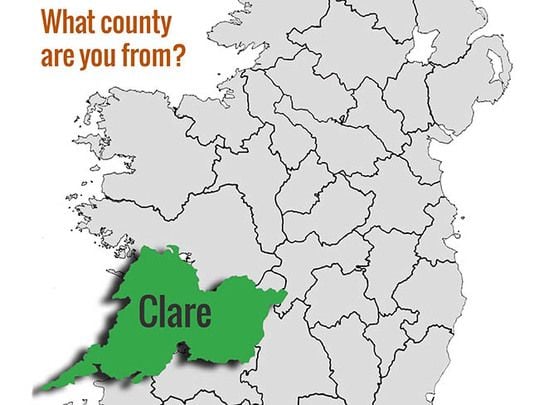From a brief history to the most common surnames and the top attractions, here's a crash guide to County Clare.
Irish Name: Contae an Chlair
Nickname: Banner County
Population: 118,817 (as of 2016)
Area: 1,300 square miles
Province: Munster
County Town: Ennis
GAA Colors: Saffron and Blue
Common Surnames from County Clare
The more common surnames in County Clare include McMahon, McNamara, O'Brien, Moloney, Ryan, Kelly, Mclnerney, O'Connor, Keane, O'Halloran, Hogan, Burke, Murphy, Lynch and Walsh.
Famous People with Clare roots
Brian Boru - High King of Ireland, Former President of Ireland Patrick Hillery, U.S. Senator Chris Dodd, Frederick William Burton - former director of British National Gallery, John Holland - inventor of the modern submarine, Michael Cusack - the founder of the Gaelic Athletic Association, Paddy Hannon - who discovered the Golden Mile in Australia, The "Liberator" Daniel O'Connell, Eamon De Valera - former President of Ireland, Archbishop Clancy of Melbourne, the Durack Family of Australia.
A brief history of County Clare
County Clare's name comes from the Irish word Clár, meaning a board or plank. A board was placed across the river Fergus outside Ennis, at a place which was to become known as Clare.
The area of what is now County Clare was divided into cantreds or baronies, each occupied by their ruling families. The O'Loughlins, O'Garbhs, O'Briens, O'Connors, O'Deas, McMahons, and McNamaras were the main clans.
The O'Briens were a major force in Thomond from earliest times. The Vikings raided Clare on many occasions during the 9th and 10th centuries. They were finally defeated at the beginning of the 11th century by the most famous of the O'Briens, Brian Boru, who led the army which defeated the Danes of Dublin at the Battle of Clontarf in 1014.
The county was badly affected by the Great Famine of 1845-47. The population was 286,000 in 1841 and by 1851 had shrunk to 212,000. Over 50,000 people died between 1845 and 1850 and thousands of others emigrated to the United States, Australia and elsewhere. The decline in population continued during the following century, reacing a low of 73,500 in 1966. However, the population of Clare has been increasing in recent years and as of the last census – 2011 – the population was 118,000.
Key attractions in County Clare
Bunratty Castle & Folk Park: Bunratty Castle is the most complete and authentic medieval castle in Ireland. Built in 1425, and plundered on many occasions, it was authentically restored in 1954 to its former medieval splendor, with furnishings and tapestries capturing the mood and style of the times. Famous Medieval Banquets are held nightly. Within its grounds is Bunratty Folk Park, where Irish village life at the turn of the century is recreated.
Cliffs of Moher & O'Briens Tower: Just north of Lahinch, on the coast of West Clare, are the famous Cliffs of Moher, defiantly standing as giant natural ramparts against the aggressive might of the Atlantic Ocean. The Cliffs of Moher (Great Wall of Thomond) and O'Brien's Tower, which stands out on a headland, shows the extent of the O'Brien influence on the area.
* Originally published in 2016. Updated in 2022

Are you planning a vacation in Ireland? Looking for advice or want to share some great memories? Join our Irish travel Facebook group.




Comments